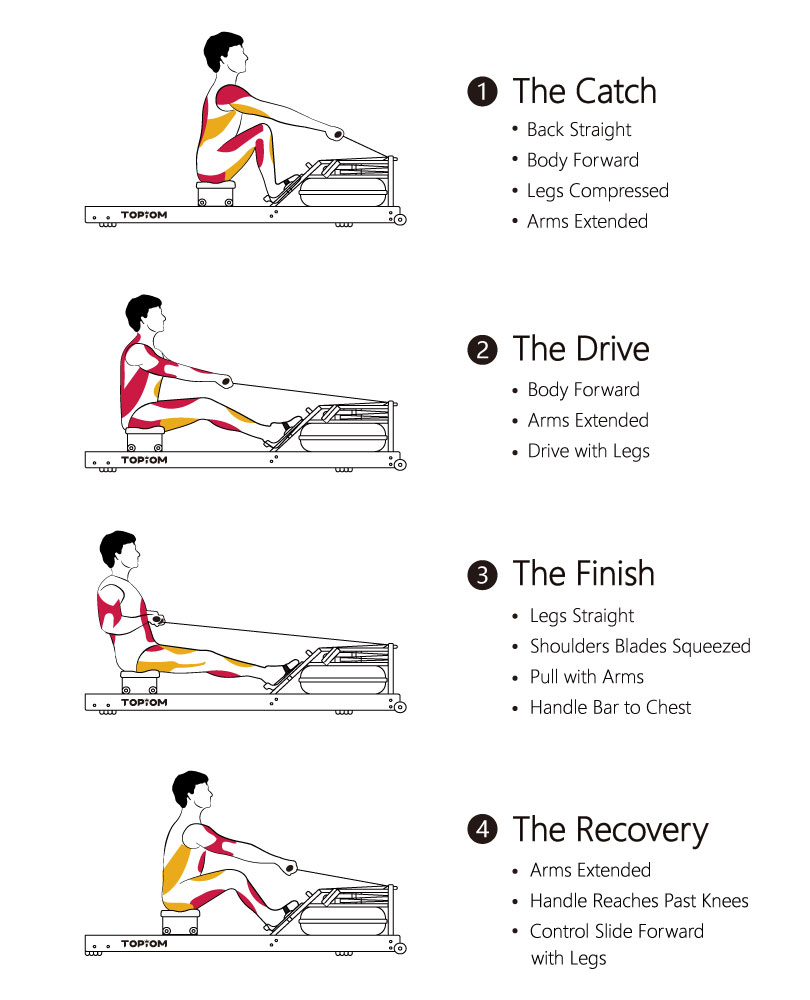Whether you want to lose weight, gain muscle, or improve your endurance, rowing is an excellent form of exercise. However, it’s not without risks as poor rowing technique can result in injury.
If you’ve never used a rowing machine before, there are some must-know techniques that will turbo-charge your ability to get the desired results FAST without risks of injury. Although there is no one-size-fits-all approach, we can all get the most out of rowing by acquiring proper rowing form and technique after learning Rowing Machine Terminology.
Table Of Contents #1 Rowing Technique: Proper Rowing Form

Table Of Contents #1 Rowing Technique: Proper Rowing Form
- 4 Phases of a Proper Rowing Stroke
- 6-word Mantra to Perform the Correct Stroke
- Create a Breathing Rhythm
- Establish a Breathing Pattern
- Synchronise Breathing for Rowing Performance
- What’s the Ideal Stroke Timing
- Why It’s the Ideal Stroke Timing
- The Drive (moving backward)
- The Recovery (moving forward)
#1. Rowing Technique: Proper Rowing Form
· 4 Phases of a Proper Rowing Stroke

> The Catch – starting position:
This is the beginning of the movement. Sit tall on the rowing machine with your arms straight, back upright, and knees and ankles flexed so that your shins are roughly vertical. From this position, relax the spine to increase flexibility in the core and use your lats to pull your shoulders down and brace your core. This engagement will help protect your lower back. Then lean forward slightly, keeping your back tall.> The Drive – transition:
Begin by pushing with your legs, while still bracing and contracting your core. When your legs are straight, hinge at the hips and lean back to about 45 degrees. The last movement is from your arms as you pull the handle towards your torso, a few inches above your belly button. Note the specific order of body movements: legs, core, hips and shoulders, arms.> The Finish – ending position:
Sometimes refered to as the release, the Finish is the resting position opposite the Catch position—although you won’t rest here for long. Legs are long, shoulders and back are leaning away from the legs, hands (and handle) are pulled in toward the body, and elbows are tucked in toward the torso.> The Recovery – another transition back to the start:
Now do the Drive movements in reverse order to return to the Catch position. Extend the arms, hinge the hips forward to bring the torso over the legs, then bend the knees.· 6-word Mantra to Perform the Correct Stroke
If you find it’s hard to remember, here’s a handy way to remember how to row: legs, core, arms (on the way out) and arms, core, legs (on the way in). At the start of the stroke (in the catch position), you should extend your legs, hinge your core, and then use your arms to row the handle toward your chest. On the way back to the beginning, you should then reversed it: extend your arms, let your core hinge forward, then bend your legs. You can repeat this mantra in your head. Slow down, execute the sequence, and get it right. Legs, core, arms, arms, core, legs. A lot of the power actually comes from the legs, but you need to keep your core tight while you push back and eventually pull the handles with your hands/arms. Pretty simple, right? Focus on this simple instruction and your technique, rather than trying to go as fast as possible. Once you dial it in, you will find your input decreased, but your output increased. Gradually you will row further with less effort and enjoy rowing more without hurting yourself.#2. Rowing Technique: Breathing
Breathing? Some may think it is something that we do every day without even thinking about it. When it comes to breathing while rowing, which is one of the most challenging endurance sports, proper breathing is critical for your success in rowing. Because it is essential to sustain the amount of work required and achieve your workout goal. Have you ever wondered what’s the right way to breathe on the rower? You may follow the breakdown instructions for practicing breathing on the rowing machine from coach Shane Farmer, the founder of Dark Horse Rowing. Training with breathing techniques can be key to improving your endurance and performance. Scroll down to find some tips to help you breathe better on a rowing machine.· Create a Breathing Rhythm
Creating a breathing rhythm can really help your rowing workouts. Ideally, the rhythm of your breath will relate to the rhythm of your stroke. When rowing at lower intensities, many rowers take one breath per stroke. They add a second, shorter breath as they start rowing harder. The optimal point of when to switch from one to two breaths per stroke is highly personal. You need to experiment yourself to find out your own breathing rhythm.· Establish a Breathing Pattern
The key to proper breathing is to establish a breathing pattern and stick with it throughout your row. Maintaining a steady breathing pattern supplies your muscles with regular oxygen. It helps the muscles to function optimally, and get the stamina to increase the intensity of your workout. It’s helpful to coordinate the timing of your breathing with the phases of the stroke. > During low-intensity rowing (one breath)—Exhale gradually on the drive, expelling all remaining air at the finish. Inhale on the recovery. > During high-intensity rowing (two breaths)—Exhale as you finish the drive. During the recovery, inhale, then exhale quickly. Inhale again just before the catch.· Synchronise Breathing for Rowing Performance
Many exercise experts think it’s important to coordinate your breathing with rowing. Because synchronizing the contractions of the chest muscles involved in breathing with the chest muscles used to drive the handles through the water might improve your efficiency of exercise and reduce overall oxygen requirements. Note: *If you’re having trouble breathing, it’s probably because you’re rushing forward and shorting yourself on your inhale.#3 Rowing Technique: Power
The most common misconception about rowing is that it’s all about the arms. When using a rowing machine for the first time, new rowers tend to let the arms do all the work. However, you may seriously hurt your arms and shoulders if use only your arms. So how to apply power to perform a good rowing stroke?Rowing engages 86 percent of your muscles. Each Stroke involves 65 to 75 percent legs (glutes, quadriceps, calves) and 25 to 35 percent upper body (arms, pectorals, abdominals, upper back) effort. — American Fitness Professionals Association.About 60 percent of your power should come from pushing with your legs. You use your feet to push against the footplates to build up the power. Roughly 20 percent of your power should be coming from pulling with your arms, while 20 percent is from bracing your core, which helps transfer energy from your legs to your upper body for effective rowing.

